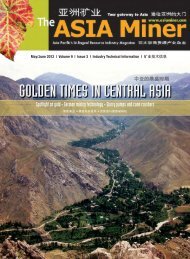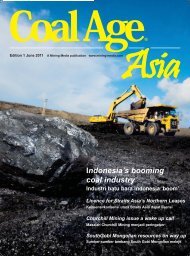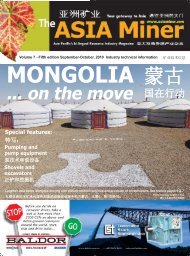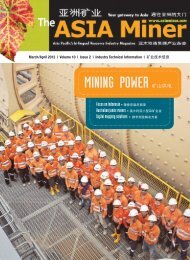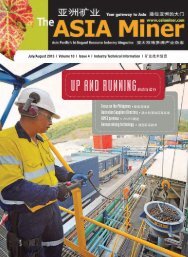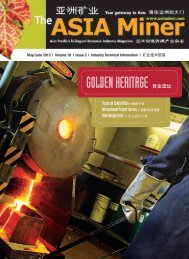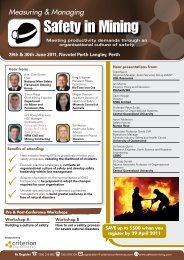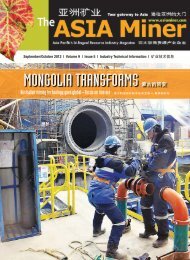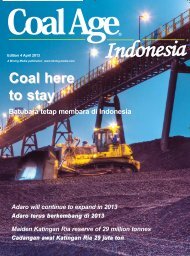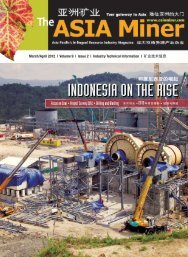MINING WELCOME 欢迎采矿 - The ASIA Miner
MINING WELCOME 欢迎采矿 - The ASIA Miner
MINING WELCOME 欢迎采矿 - The ASIA Miner
You also want an ePaper? Increase the reach of your titles
YUMPU automatically turns print PDFs into web optimized ePapers that Google loves.
Company Profile<br />
GOLDEN FUTURE FOR KULA GOLD’S WOODLARK ISLAND<br />
ONGOING drilling has confirmed further high grade gold<br />
mineralization immediately east of the 685,000 ounce<br />
Kulumadau resource at Kula Gold’s Woodlark Island Gold<br />
Project in Papua New Guinea. <strong>The</strong> company plans to<br />
continue its exploration program to establish a resource<br />
at Kulumadau East, thereby adding to the existing overall<br />
Woodlark Island resource of 1.84 million ounces.<br />
Step-out drilling between the Kulumadau resource<br />
and the new Kulumadau East discovery has confirmed<br />
two new zones of significance. <strong>The</strong> latest mineralization<br />
is reasonably shallow and may result in all of the Kulumadau<br />
zones being included in a single pit, enhancing<br />
project economics. Significant new assay results<br />
include 9 metres from 134 metres @ 40 grams/tonne<br />
gold, including 1 metre @ 284 grams/tonne; 10 metres<br />
from 85 metres @ 3 grams/tonne; 16 metres from 28<br />
metres @ 2.6 grams/tonne; and 10 metres from 139<br />
metres @ 3 grams/tonne.<br />
Kula Gold’s managing director Lee Spencer says,<br />
“While continuing to add additional resources, the company<br />
is focused on delivering a feasibility study and advancing<br />
the project into the permitting stage in 2012.”<br />
Engineering studies are continuing with the definitive feasibility<br />
study due to be completed at the end of quarter 1.<br />
Woodlark Island is in the Trobriand Island Group in<br />
the Solomon Sea, Milne Bay Province, 550km northeast<br />
of Port Moresby. <strong>The</strong> island is reasonably large, about<br />
1750sqkm, but remote and relatively isolated.<br />
Kula Gold’s flagship project is Woodlark Island in the Solomon Sea, 550km northeast of Port Moresby.<br />
Drilling at the Busai deposit of Kula Gold’s Woodlark Island project.<br />
However, this was not always the case. In the late 19th<br />
Century alluvial gold was discovered resulting in a gold<br />
rush and declaration of the Murua Goldfield on November<br />
6, 1895. <strong>The</strong> gold rush included more than 500 miners<br />
and 2000 labourers from Cooktown and the nearby first<br />
proclaimed Louisiade Goldfield Islands of Sudest and Misima.<br />
Unlike most other goldfields of this era in PNG, gold<br />
production was sustained over a number of years by the<br />
accidental discovery of gold-bearing veins and lodes exposed<br />
by sluicing off a young sedimentary sequence<br />
which covers the bulk of the island.<br />
<strong>The</strong> Kulumadau Gold Mining Company operated continuously<br />
until it shut down in May 1918 with production<br />
of about 75,000 ounces for a recovered grade of 17<br />
grams/tonne gold. <strong>The</strong> mine operated on seven levels<br />
from two shafts and although still in ore at depth, increasing<br />
costs with the onset of World War I sealed its fate.<br />
Including gold produced from alluvials documented<br />
in Government sources, a total of 231,000 ounces<br />
were produced from Woodlark until 1963. Some<br />
216,000 ounces were produced prior to 1926, which<br />
represents 37% of all gold produced from the colonial<br />
period of Papua up until this period. In addition, the Kulumadau<br />
mine produced on average 16% of gross export<br />
earnings from Papua from 1902 to 1918.<br />
Modern gold exploration was initiated on Woodlark<br />
Island in 1962 with the Bureau of <strong>Miner</strong>al Resources<br />
undertaking surface geochemistry, limited geophysics<br />
and diamond drilling in 1962 and 1963 at Kulumadau.<br />
Since 1970 Woodlark Island has been subject to 40<br />
years of mostly continuous modern exploration without<br />
sufficient resources being established to warrant investment<br />
in a mining operation until recently. Exploration<br />
in the past has been concentrated around the<br />
old historical mining centres of Kulumadau, Busai and<br />
Boniavat, with the early exploration strategy being<br />
heavily dependent upon surface geochemistry, geophysics<br />
and geological mapping.<br />
<strong>The</strong> large amount of young sedimentary cover overlying<br />
prospective Miocene volcanic terrain has severely<br />
restricted the use of traditional exploration methods to<br />
the extent that until 1997, global resources at Woodlark<br />
Island were 6.7 million tonnes @ 1.73 grams/tonne<br />
gold for 378,500 ounces estimated at the two historical<br />
centres of Kulumadau and Busai.<br />
Recognizing that the key to exploration success was<br />
low-cost RC drilling on coincident structural dilation<br />
centres and aeromagnetic lows through the overlying<br />
young cover, Woodlark Mining, the 100%-owned subsidiary<br />
of ASX-listed Kula Gold, embarked on an ambitious<br />
drilling program resulting in more than 200,000<br />
metres of RC and 20,000 metres of diamond drilling<br />
over a six year period. Drilling to date has targeted mineralization<br />
at the historical mining centres of Kulumadau,<br />
Busai and Boniavat although new zones have<br />
18 | <strong>ASIA</strong> <strong>Miner</strong> | January/February 2012



